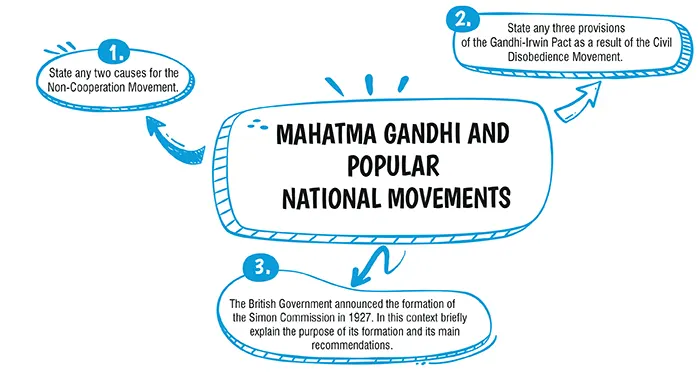Home / Board / ICSE / important Questions / Class 10 / History & Civics / Mahatma Gandhi and Popular National Movements
Table of Contents

Ans. (d) Gandhi-Irwin Pact
Explanation:
The Civil Disobedience Movement concluded due to the signing of the Gandhi-Irwin Pact on March 5, 1931, between Mahatma Gandhi and the Viceroy of India, Lord Irwin.
Ans. (a) The Maker of Modern India
Explanation:
He was known as "The father of the Indian unrest" by British colonial authorities, conferred with the title of "Lokmanya" (meaning "accepted by the people as their leader"), and referred to as "The Maker of Modern India" by Mahatma Gandhi.
Explanation:
Two causes for the Non-Cooperation Movement were :
1.The Rowlatt Act was passed in March 1919 which gave extraordinary powers to the British to imprison any person without trial. There was a terrible massacre at Jallianwala Bagh, Amritsar on April 13, 1919 which led to the Non-Cooperation Movement.
2.The Khilafat Movement was started by Ali Brothers in August 1920 for the preservation of Khalifa, the religious head of the Muslims. Gandhiji combined the Khilafat Movement with the Non Cooperation Movement as he saw this as an opportunity to unite the Hindus and Muslims.
Explanation:
The government, in a significant move, agreed to a series of concessions during negotiations. These included the withdrawal of all ordinances, the release of all political prisoners except those involved in violent activities, the permission for peaceful picketing of liquor and foreign cloth shops, and the revocation of the ban on the INC. These agreements marked a turning point in the political landscape at the time.
Explanation:
However, the Simon Commission completed its task and submitted its report. The following were the main features of the report :
(i) Complete autonomy in the Provinces, including the department of law and order, but the Governor was given overriding powers in certain matters.
(ii) British troops and British officers to stay on in Indian regiments for many years.
(iii) Federal Government at the centre, embracing not only British Indian but the Princely States as well.
(iv) Provincial Legislative Councils to be enlarged.
(v) The Governor-General to select and appoint members of his cabinet.
(vi) High Courts to be under the administrative control of the Government of India.
Download Mind Map of this chapter
Download NowWant to Practice Mock Tests of this chapter
Practice NowDownload Important Questions of this chapter
Download NowCBSE Important Questions Class 10
ICSE Important Questions Class 10
CBSE Important Questions Class 10
ICSE Important Questions Class 10